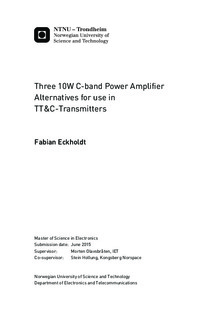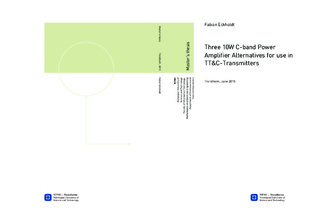| dc.description.abstract | This thesis describes the first stage in designing and realizing three 10W C-band power
amplifier alternatives based on the GaN-technology for use in Kongsberg Norspace future
TT&C-transmitters. The operational frequency range spanned from 3.4GHz to 4.25GHz.
It was decided to build one single-stage amplifier based on the 10W CGH40010F transistor
from Cree and two dual-stage amplifiers with a balanced second stage based on the 6W
CGH40006P transistor, from the same manufacturer. AWilkinson power divider was used
to feed each branch in the second stage.
In the design procedure, source and load pull simulations were performed in order to
retrieve the optimal impedances for each transistor and as a basis for the design of the
matching networks. By utilizing a looping method in the design process of the matching
networks, it was possible to obtain results that, to some extent, fulfilled the requirements.
Simulations and design were carried out in ADS by Keysight (former Agilent).
The simulated results showed that all three designs were capable of delivering 10W
output power throughout the frequency band. The single-stage amplifier obtained a simulated
power added efficiency (PAE) above 45% at 40dBm output power, while the two
dual-stage designs achieved a PAE between 41-44% and 34-36%, respectively.
S-parameter simulations reviled that the single-stage design accomplished a small signal
gain of 11.3dB-11.7dB, while the input reflection coefficients varied between -3dB
and -5dB. To achieve the requirement of having the input reflection coefficients less than
-10dB, the dual-stage designs utilized an attenuator with 1.5dB loss at the input match,
both designs obtained a small signal gain above 20dB.
Like the simulated results, the large signal measurements showed that the amplifiers
were capable of delivering 10W output power, except the single-stage design at
4.0375GHz (which were one of the test frequencies). The measured power added efficiency
for the single-stage amplifier varied between 27%-44%, while the two dual-stage
amplifiers obtained a PAE between 39-43% and 35-42%, respectively. This implied that
non of the designs managed to fulfill the requirement of having a total power consumption
less than 25W over the specified frequency range.
A simulated large signal stability analysis were performed on each design and the results
revealed that one of the dual-stage designs had a potential instability around 790MHz,
and practical spectrum measurements confirmed frequency components at 750MHz, 1.51GHz
and 2.25GHz. However, the spurious frequency components had no measurable impact on
the performance.
A small section presenting the future prospects in terms of utilizing the GaN-technology
in Space and suggestions for future work, have also been included.
The thesis concluded that several iterations must be done before an integration with
the transmitter can be made. | |

